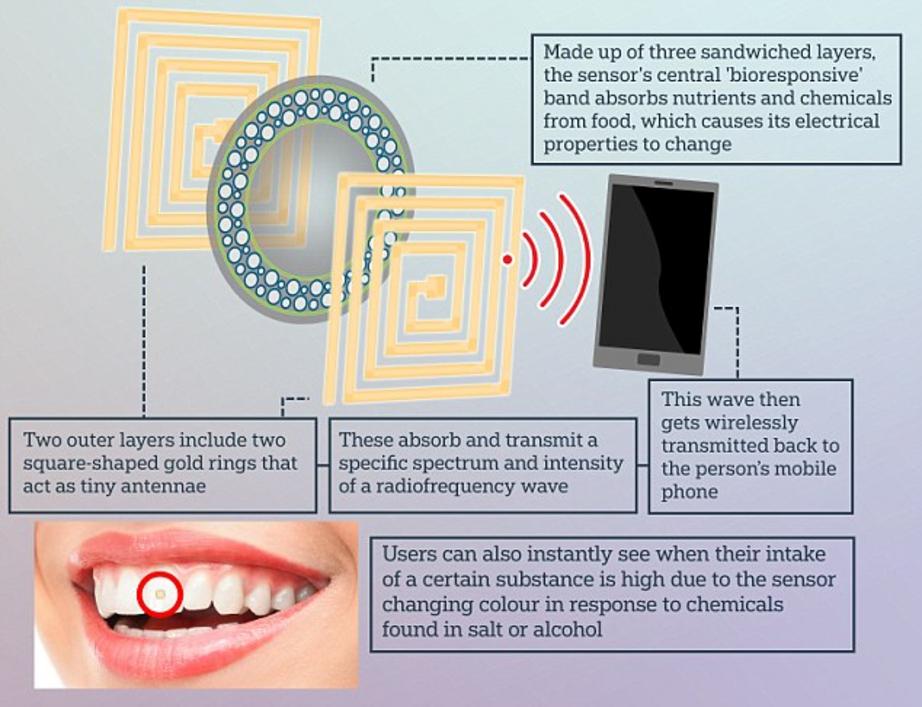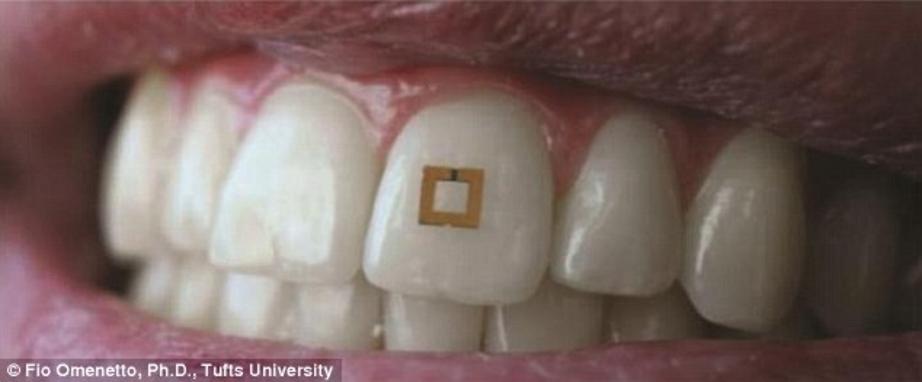A new sensor worn on teeth records what people eat in a day
- Sensor is mounted directly on to a tooth and connects wirelessly to mobiles
- Measuring just 2x2mm, it overcomes limitations, such as wearing a mouth guard
- According to the researchers, the device adheres well to uneven tooth surfaces
- A central 'bioresponsive' layer absorbs nutrients and chemicals from food
- The sensor changes so users can instantly determine their food intakes
The sensor, which is mounted directly on to a tooth and connects wirelessly to a user's mobile phone, records information on their sugar, salt and alcohol intakes, a study by Tufts University found.
The researchers believe the device could help people manage their nutritional inputs, leading to improved health and diet outcomes.

Such sensors could also be used to monitor dental health, as well as potentially collecting saliva samples to measure wellbeing complications, such as fatigue, they add.
Measuring just 2x2mm, the device overcomes previous limitations of such technologies, including requiring users wear a mouth guard, and adheres well to uneven teeth surfaces, according to the researchers.
It is unclear when such a device may be available for public use.
[image id=100599]
A new sensor worn on teeth records everything a person eats or drinks in a day (stock)

A 'bioresponsive' layer absorbs nutrients and chemicals from food, which causes the sensor's electrical properties to change. Antennae then absorb and transmit a specific spectrum and intensity of radiofrequency wave, which gets wirelessly transmitted to the user's phone
HOW DOES THE SENSOR WORK?
Made up of three sandwiched layers, the sensor's central 'bioresponsive' band absorbs nutrients and chemicals from food, which causes its electrical properties to change.
The outer layers, which include two square-shaped gold rings, act as tiny antennae.
These absorb and transmit a specific spectrum and intensity of a radiofrequency wave.
This wave then gets wirelessly transmitted back to person's mobile phone.
Users can also instantly see when their intake of a certain substance is high due to the sensor changing in response to chemicals found in salt or alcohol.

How could the sensor be used?
Speaking of the implications of the device, study author Dr Fiorenzo Omenetto from Tuft University, told Alphr: 'Managing and interpreting the data that this device provides can ultimately lead to the identification of patterns of consumption that could have an impact on diet regimens, health management, and maybe make us more aware our nutritional intake.
'One could envision nutrition monitoring and relate that to nutrition management.
'On the other hand, sampling and monitoring analytes in the oral cavity could help in a number of ways: from monitoring dental health to monitoring fatigue through saliva sampling.'
'We are limited only by our creativity'
The researchers add the sensor does not include bulky wires or require changing regularly.
Reports suggest the sensor only lasts up to two days, however, further development could extend this.
The device can also be attached to other body parts and be tweaked to pick up on many different chemicals.
Dr Omenetto added: 'In theory we can modify the bioresponsive layer in these sensors to target other chemicals - we are really limited only by our creativity.
'We have extended common RFID [radiofrequency ID] technology to a sensor package that can dynamically read and transmit information on its environment, whether it is affixed to a tooth, to skin, or any other surface.'
The findings will be published in the journal Advanced Materials.
[image id=100601]
The sensor (pictured), which is mounted directly on to a tooth and connects wirelessly to a user's mobile phone, records information on their sugar, salt and alcohol intakes
Braces containing LED lights cut the time and cost of tooth straightening
This comes after research released last October suggested new flashy dental braces that include lights and a battery on every tooth, could cut the time and costs involved in straightening teeth.
The 3D-printed, semi-transparent braces involve placing two LED lights and one non-toxic lithium battery on every tooth.
The batteries provide energy to power the LEDs, which are programmed by a dentist to provide light therapy according to each tooth's needs.
Light therapy enhances bone regeneration, which may therefore reduce the time and subsequent cost involved in realigning teeth.
It is thought to do this by altering the teeth's cells' DNA to increase their energy supply, which allows them to move faster and therefore be more quickly straightened.
The braces' LEDs will not be visible due to them emitting a light wavelength that cannot be seen by the naked eye.
